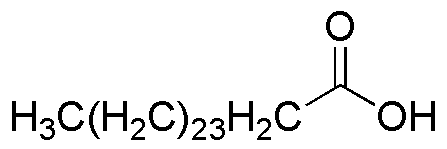Hexacosanoic acid is widely utilized in research focused on:
- Biotechnology: It serves as a fatty acid component in the synthesis of biofuels, enhancing the efficiency of renewable energy sources.
- Cosmetics: This compound is incorporated into skincare products for its emollient properties, providing moisture and improving skin texture.
- Pharmaceuticals: Hexacosanoic acid is explored for its potential in drug delivery systems, helping to improve the solubility and bioavailability of certain medications.
- Food Industry: It is used as a food additive and preservative, contributing to the stability and shelf life of various products.
- Material Science: This fatty acid is applied in the development of biodegradable polymers, promoting sustainability in manufacturing processes.
General Information
Properties
Safety and Regulations
Applications
Hexacosanoic acid is widely utilized in research focused on:
- Biotechnology: It serves as a fatty acid component in the synthesis of biofuels, enhancing the efficiency of renewable energy sources.
- Cosmetics: This compound is incorporated into skincare products for its emollient properties, providing moisture and improving skin texture.
- Pharmaceuticals: Hexacosanoic acid is explored for its potential in drug delivery systems, helping to improve the solubility and bioavailability of certain medications.
- Food Industry: It is used as a food additive and preservative, contributing to the stability and shelf life of various products.
- Material Science: This fatty acid is applied in the development of biodegradable polymers, promoting sustainability in manufacturing processes.
Documents
Safety Data Sheets (SDS)
The SDS provides comprehensive safety information on handling, storage, and disposal of the product.
Product Specification (PS)
The PS provides a comprehensive breakdown of the product’s properties, including chemical composition, physical state, purity, and storage requirements. It also details acceptable quality ranges and the product's intended applications.
Certificates of Analysis (COA)
Search for Certificates of Analysis (COA) by entering the products Lot Number. Lot and Batch Numbers can be found on a product’s label following the words ‘Lot’ or ‘Batch’.
*Catalog Number
*Lot Number
Certificates Of Origin (COO)
This COO confirms the country where the product was manufactured, and also details the materials and components used in it and whether it is derived from natural, synthetic, or other specific sources. This certificate may be required for customs, trade, and regulatory compliance.
*Catalog Number
*Lot Number
Safety Data Sheets (SDS)
The SDS provides comprehensive safety information on handling, storage, and disposal of the product.
DownloadProduct Specification (PS)
The PS provides a comprehensive breakdown of the product’s properties, including chemical composition, physical state, purity, and storage requirements. It also details acceptable quality ranges and the product's intended applications.
DownloadCertificates of Analysis (COA)
Search for Certificates of Analysis (COA) by entering the products Lot Number. Lot and Batch Numbers can be found on a product’s label following the words ‘Lot’ or ‘Batch’.
*Catalog Number
*Lot Number
Certificates Of Origin (COO)
This COO confirms the country where the product was manufactured, and also details the materials and components used in it and whether it is derived from natural, synthetic, or other specific sources. This certificate may be required for customs, trade, and regulatory compliance.

